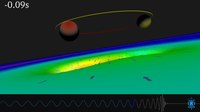
Photo from wikipedia
At the beginning of 2016, the first direct detection of a gravitational wave by a laser-based Michelson interferometer has been reported. So far, the number of confirmed detections has raised… Click to show full abstract
At the beginning of 2016, the first direct detection of a gravitational wave by a laser-based Michelson interferometer has been reported. So far, the number of confirmed detections has raised to three and will certainly increase further. Thereby, mankind has an amazing new tool to observe and study the universe, namely by gravitational wave astronomy. However, in order to develop their full potential, a more sensitive generation of earth-bound gravitational wave detectors will be required in the future. Current detectors are operating with solid-state laser systems at 1064 nm but higher output power levels and longer wavelengths will be required by next-generation detectors. The requirements with respect to the laser sources, e.g., on the beam quality and the linewidth, are very challenging and unique. In recent years, it has been demonstrated that single-frequency fiber amplifiers are a very attractive concept as next-generation gravitational wave detectors laser sources. This paper reviews, highlights, and summarizes the corresponding research results, in particular, regarding power scaling, noise properties, and coherent beam combination.
Journal Title: IEEE Journal of Selected Topics in Quantum Electronics
Year Published: 2018
Link to full text (if available)
Share on Social Media: Sign Up to like & get
recommendations!